2015 PEUGEOT 5008 tow
[x] Cancel search: towPage 253 of 364
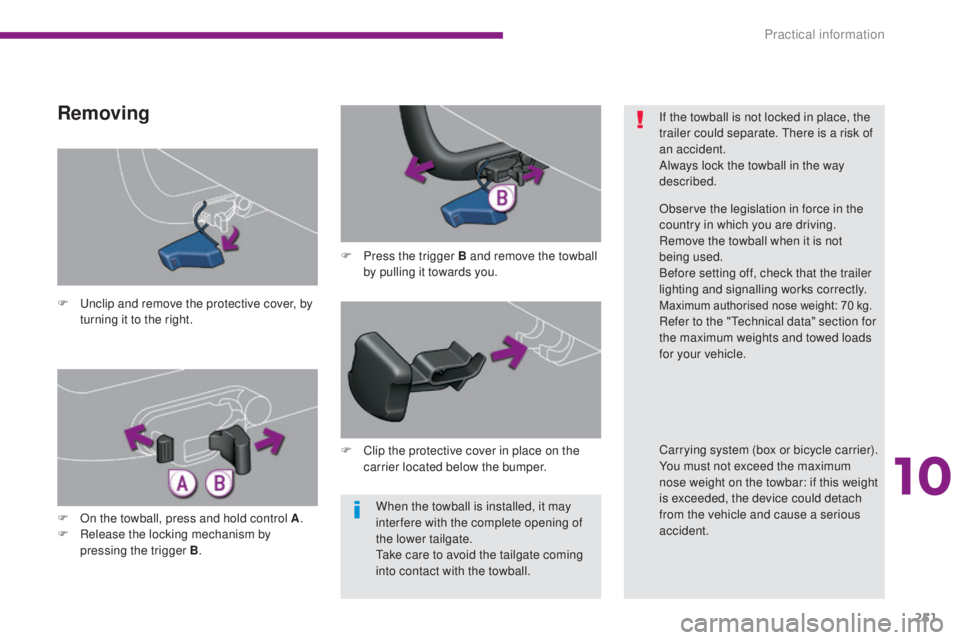
251
When the towball is installed, it may
inter fere with the complete opening of
the lower tailgate.
Take care to avoid the tailgate coming
into contact with the towball.
F
U
nclip and remove the protective cover, by
turning it to the right.
Removing
F Press the trigger B and remove the towball by pulling it towards you.
F
O
n the towball, press and hold control A .
F
R
elease the locking mechanism by
pressing the trigger B . F
C
lip the protective cover in place on the
carrier located below the bumper. If the towball is not locked in place, the
trailer could separate. There is a risk of
an accident.
Always lock the towball in the way
described.
Observe the legislation in force in the
country in which you are driving.
Remove the towball when it is not
being used.
Before setting off, check that the trailer
lighting and signalling works correctly.
Maximum authorised nose weight: 70 kg.Refer to the "Technical data" section for
the maximum weights and towed loads
for your vehicle.
Carrying system (box or bicycle carrier).
You must not exceed the maximum
nose weight on the towbar: if this weight
is exceeded, the device could detach
from the vehicle and cause a serious
accident.
10
Practical information
Page 254 of 364

252
Towing a trailer
Your vehicle is primarily designed for
transporting people and luggage, but it may
also be used for towing a trailer.Refer to the "Technical data" section for
details of the weights and towed loads
which apply to your vehicle.
We recommend the use of genuine
PEUGEOT towbars and their harnesses
that have been tested and approved
from the design stage of your vehicle,
and that the fitting of the towbar is
entrusted to a PEUGEOT dealer or a
qualified workshop.
If the towbar is not fitted by a
PEUGEOT dealer, it is imperative that it
is fitted in accordance with the vehicle
manufacturer's instructions.
Driving with a trailer places greater
demands on the towing vehicle and the
driver must take particular care.
If the trailer starts to sway, you risk
losing control. The trailer could
overturn. There is a risk of an accident.
Do not try to correct the trailer's
movement by accelerating. Reduce
your speed and do not counter-steer.
Brake if necessary.
Driving advice
Distribution of loads
F Distribute the load in the trailer so that the heaviest items are as close as possible to
the axle and the nose weight approaches
the maximum permitted without
exceeding
it.
Air density decreases with altitude, thus
reducing engine performance. Above
1
000 metres, the maximum towed load must
be reduced by 10
% for every 1 000 metres of
altitude.
Practical information
Page 255 of 364

253
Side wind
F Take into account the increased sensitivity to side wind.
Cooling
Towing a trailer on a slope increases the
temperature of the coolant.
As the fan is electrically controlled, its cooling
capacity is not dependent on the engine speed.
F
T
o lower the engine speed, reduce your
speed.
The maximum towed load on a long incline
depends on the gradient and the ambient
temperature.
In all cases, keep a check on the coolant
temperature.
Braking
Towing a trailer increases the braking distance.
To avoid overheating of the brakes on a long
mountain type of descent, the use of engine
braking is recommended.
Ty r e s
F Check the tyre pressures of the towing vehicle and of the trailer, observing the
recommended pressures.
Lighting
F Check the electrical lighting and signalling on the trailer.
The rear parking sensors will be
deactivated automatically if a genuine
PEUGEOT towbar is used.
F
I
f the warning lamp and the
STOP
warning lamp come on, stop the
vehicle and switch off the engine as
soon as possible.
10
Practical information
Page 257 of 364
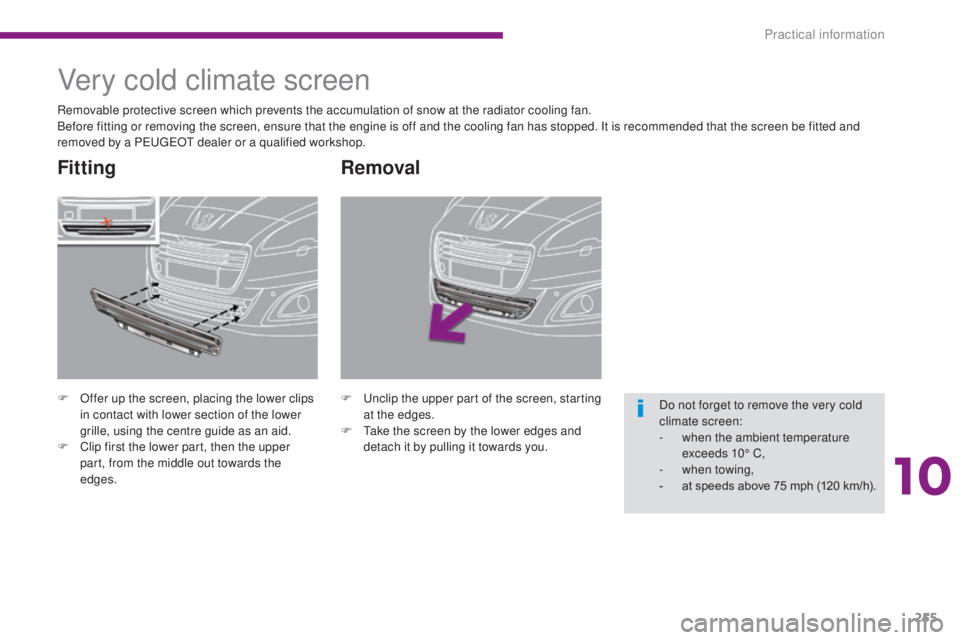
255
Removal
F Unclip the upper part of the screen, starting at the edges.
F
T
ake the screen by the lower edges and
detach it by pulling it towards you.
Very cold climate screen
F Offer up the screen, placing the lower clips in contact with lower section of the lower
grille, using the centre guide as an aid.
F
C
lip first the lower part, then the upper
part, from the middle out towards the
edges.
Fitting
Removable protective screen which prevents the accumulation of snow at the radiator cooling fan.
Before fitting or removing the screen, ensure that the engine is off and the cooling fan has stopped. It is recommended that the screen be fitted and
removed by a PEUGEOT dealer or a qualified workshop.
Do not forget to remove the very cold
climate screen:
-
w
hen the ambient temperature
exceeds 10° C,
-
w
hen towing,
-
a
t speeds above 75 mph (120 km/h).
10
Practical information
Page 258 of 364
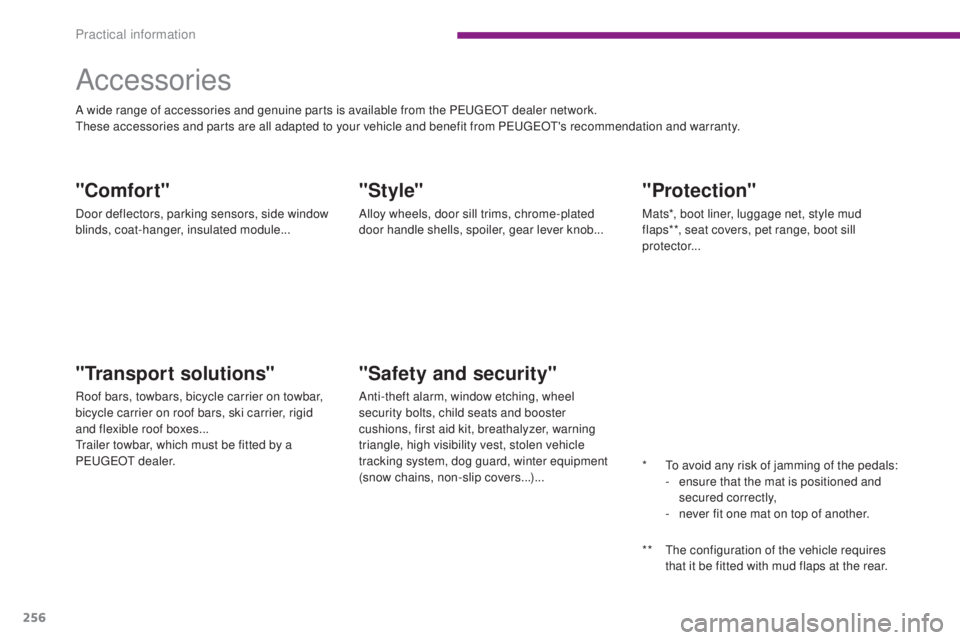
256
"Protection"
Mats*, boot liner, luggage net, style mud
flaps**, seat covers, pet range, boot sill
protector...
"Safety and security"
Anti-theft alarm, window etching, wheel
security bolts, child seats and booster
cushions, first aid kit, breathalyzer, warning
triangle, high visibility vest, stolen vehicle
tracking system, dog guard, winter equipment
(snow chains, non-slip covers...)...
Accessories
"Style"
Alloy wheels, door sill trims, chrome-plated
door handle shells, spoiler, gear lever knob...
"Transport solutions"
Roof bars, towbars, bicycle carrier on towbar,
bicycle carrier on roof bars, ski carrier, rigid
and flexible roof boxes...
Trailer towbar, which must be fitted by a
PEUGEOT dealer.
"Comfort"
Door deflectors, parking sensors, side window
blinds, coat-hanger, insulated module... A wide range of accessories and genuine parts is available from the PEUGEOT dealer network.
These accessories and parts are all adapted to your vehicle and benefit from PEUGEOT's recommendation and warranty.*
T
o avoid any risk of jamming of the pedals:
-
e
nsure that the mat is positioned and
secured correctly,
-
n
ever fit one mat on top of another.
**
T
he configuration of the vehicle requires
that it be fitted with mud flaps at the rear.
Practical information
Page 261 of 364
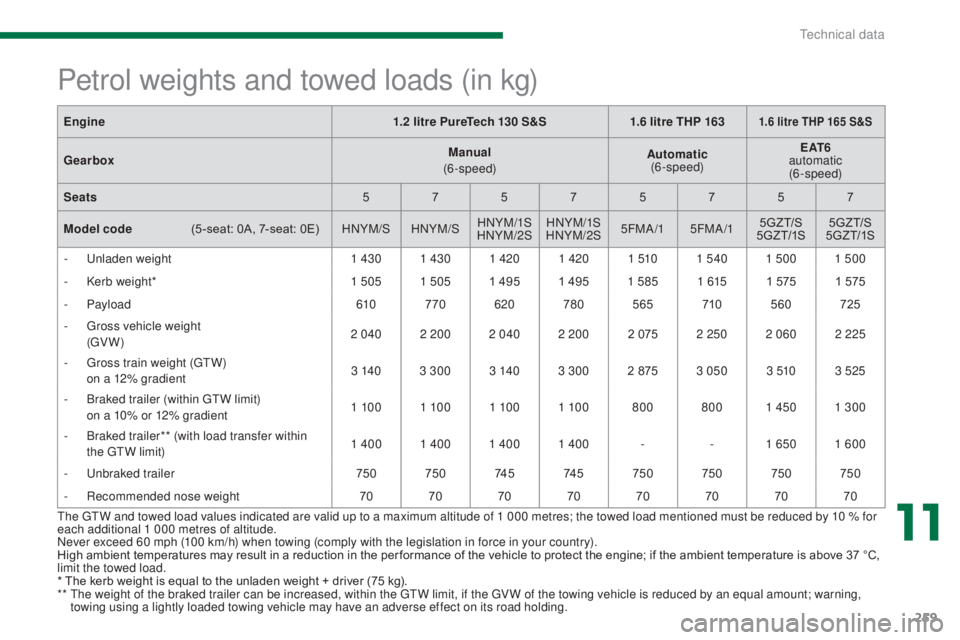
259
* The kerb weight is equal to the unladen weight + driver (75 kg).
** T he weight of the braked trailer can be increased, within the GTW limit, if the GV W of the towing vehicle is reduced by an equal amount; warning,
towing using a lightly loaded towing vehicle may have an adverse effect on its road holding.
Engine
1.2 litre PureTech 130 S&S1.6 litre THP 163
1.6 litre THP 165 S&S
Gearbox Manual
(6-speed) Automatic
(6-speed) E AT 6
automatic (6-speed)
Seats 57575757
Model code
(
5 -seat: 0A, 7-seat: 0E) HNYM/S HNYM/SHNYM/1S
HNYM/2S HNYM/1S
HNYM/2S 5FMA /1 5FMA /1 5G Z T/S
5G Z T/1S 5G Z T/S
5G Z T/1S
-
U
nladen weight 1 430 1 4301 420 1 420 1 5101 540 1 500 1 500
-
K
erb weight* 1 505 1 5051 495 1 4951 5851 6151 575 1 575
-
Payload 610770 620 780565 710560 725
-
G
ross vehicle weight
(GV W) 2 040 2 200 2 040 2 200
2 0752 250 2 060 2 225
-
G
ross train weight (GTW)
o
n a 12% gradient 3 140
3 300 3 1403 300 2 8753 050 3 5103 525
-
B
raked trailer (within GTW limit)
o
n a 10% or 12% gradient 1 10 0 1 10 0 1 10 0 1 10 0
800 8001 450 1 300
-
B
raked trailer** (with load transfer within
the GTW limit) 1 400 1 400 1 400 1 400 -
- 1 650 1 600
-
U
nbraked trailer 750 75074 5 74 5750 750 750 750
-
R
ecommended nose weight 70 70 70 70 70 70 70 70
The GTW and towed load values indicated are valid up to a maximum altitude of 1 000 metres; the towed load mentioned must be reduced by 10 % for
each additional 1 000 metres of altitude.
Never exceed 60 mph (100 km/h) when towing (comply with the legislation in force in your country).
High ambient temperatures may result in a reduction in the per formance of the vehicle to protect the engine; if the ambient temperature is above 37 °C,
limit the towed load.
Petrol weights and towed loads (in kg)
11
Technical data
Page 262 of 364
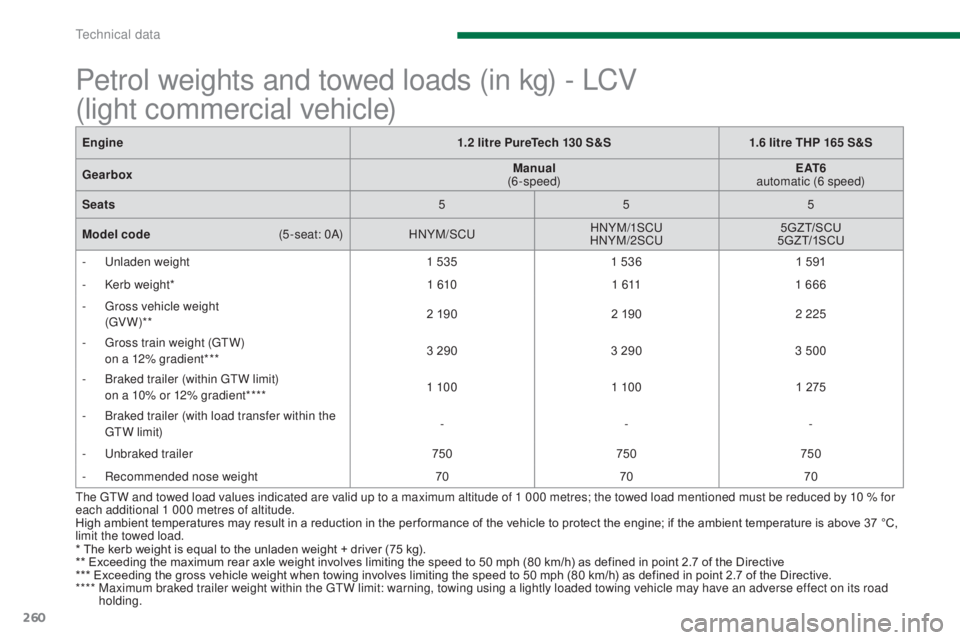
260
Petrol weights and towed loads (in kg) - LCV
(light commercial vehicle)
* The kerb weight is equal to the unladen weight + driver (75 kg).
** Exceeding the maximum rear axle weight involves limiting the speed to 50 mph (80 km/h) as defined in point 2.7 of the Directive
*** Exceeding the gross vehicle weight when towing involves limiting the speed to 50 mph (80 km/h) as defined in point 2.7 of the Directive.
****
M
aximum braked trailer weight within the GTW limit: warning, towing using a lightly loaded towing vehicle may have an adverse effect on its road
holding.
The GTW and towed load values indicated are valid up to a maximum altitude of 1 000 metres; the towed load mentioned must be reduced by 10 % for
each additional 1 000 metres of altitude.
High ambient temperatures may result in a reduction in the per formance of the vehicle to protect the engine; if the ambient temperature is above 37 °C,
limit the towed load. Engine
1.2 litre PureTech 130 S&S1.6 litre THP 165 S&S
Gearbox Manual
(6-speed) E AT 6
automatic (6 speed)
Seats 555
Model code
(
5-seat: 0A)
HNYM/SCU HNYM/1SCU
HNYM/2SCU 5GZT/SCU
5G Z T/1SCU
-
U
nladen weight
1 5351 536 1 591
-
K
erb weight*
1 6101 6 111 666
-
G
ross vehicle weight
(GV W)* * 2 190
2 1902 225
-
G
ross train weight (GTW)
o
n a 12% gradient***
3 290
3 2903 500
-
B
raked trailer (within GTW limit)
o
n a 10% or 12% gradient****
1 10 0
1 10 0 1 275
-
B
raked trailer (with load transfer within the
GTW limit) -
--
-
U
nbraked trailer
750750750
-
R
ecommended nose weight
707070
Technical data
Page 265 of 364
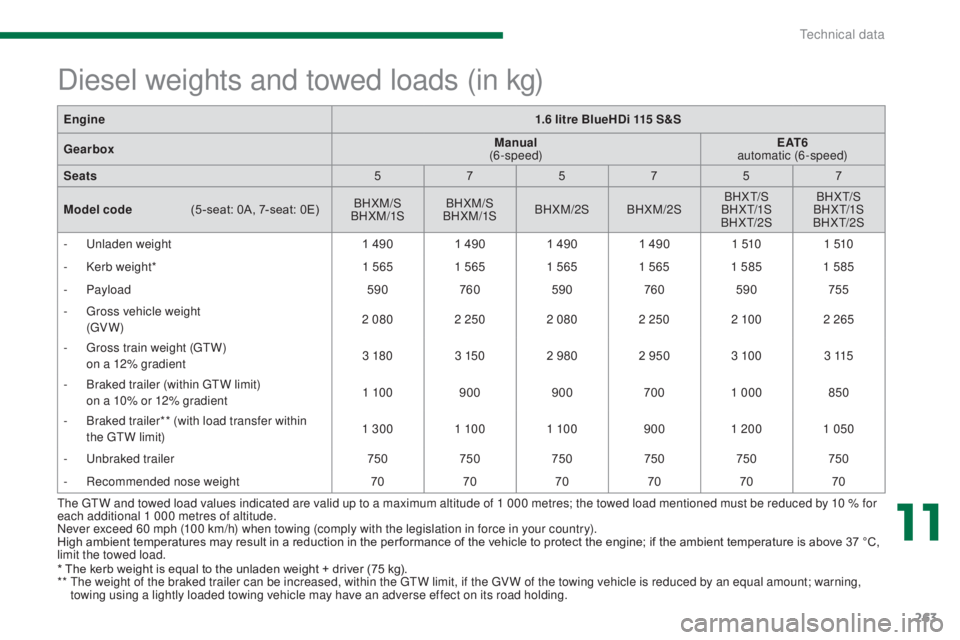
263
* The kerb weight is equal to the unladen weight + driver (75 kg).
** T he weight of the braked trailer can be increased, within the GTW limit, if the GV W of the towing vehicle is reduced by an equal amount; warning,
towing using a lightly loaded towing vehicle may have an adverse effect on its road holding.
The GTW and towed load values indicated are valid up to a maximum altitude of 1 000 metres; the towed load mentioned must be reduced by 10 % for
each additional 1 000 metres of altitude.
Never exceed 60 mph (100 km/h) when towing (comply with the legislation in force in your country).
High ambient temperatures may result in a reduction in the per formance of the vehicle to protect the engine; if the ambient temperature is above 37 °C,
limit the towed load.
Diesel weights and towed loads (in kg)
Engine
1.6 litre BlueHDi 115 S&S
Gearbox Manual
(6-speed) E AT 6
automatic (6-speed)
Seats 575757
Model code
(
5 -seat: 0A, 7-seat: 0E) BHXM/S
BHXM/1S BHXM/S
BHXM/1S BHXM/2S BHXM/2S BH X T/S
BH X T/1S
BH X T/2S BH X T/S
BH X T/1S
BH X T/2S
-
U
nladen weight 1 4901 4901 4901 490 1 5101 510
-
K
erb weight* 1 5651 5651 5651 5651 5851 585
-
Payload 590760590 760590 755
-
G
ross vehicle weight
(GV W) 2 080
2 2502 080 2 2502 10 02 265
-
G
ross train weight (GTW)
o
n a 12% gradient 3 180
3 1502 980 2 950 3 10 0 3 115
-
B
raked trailer (within GTW limit)
o
n a 10% or 12% gradient 1 10 0
900900 7001 000 850
-
B
raked trailer** (with load transfer within
the GTW limit) 1 300
1 10 01 10 0 9001 200 1 050
-
U
nbraked trailer 750750750750750750
-
R
ecommended nose weight 707070707070
11
Technical data